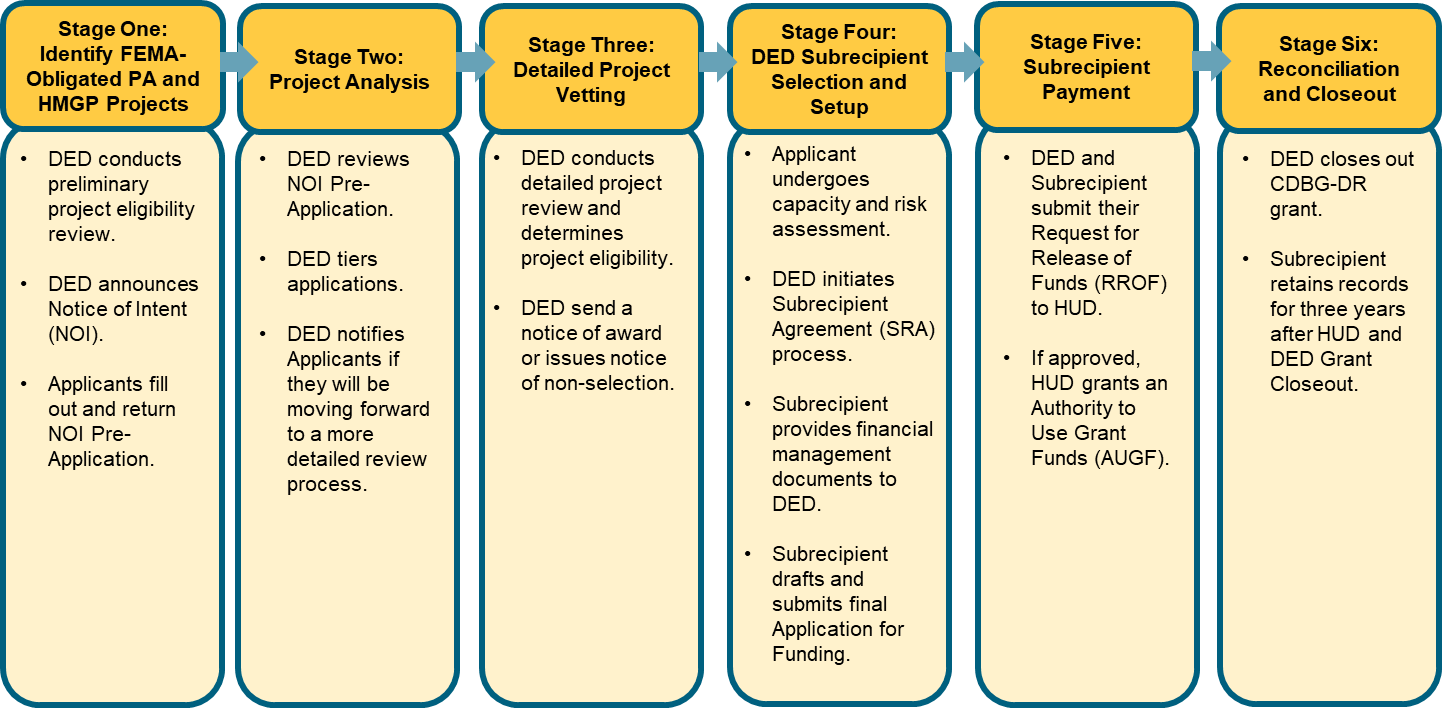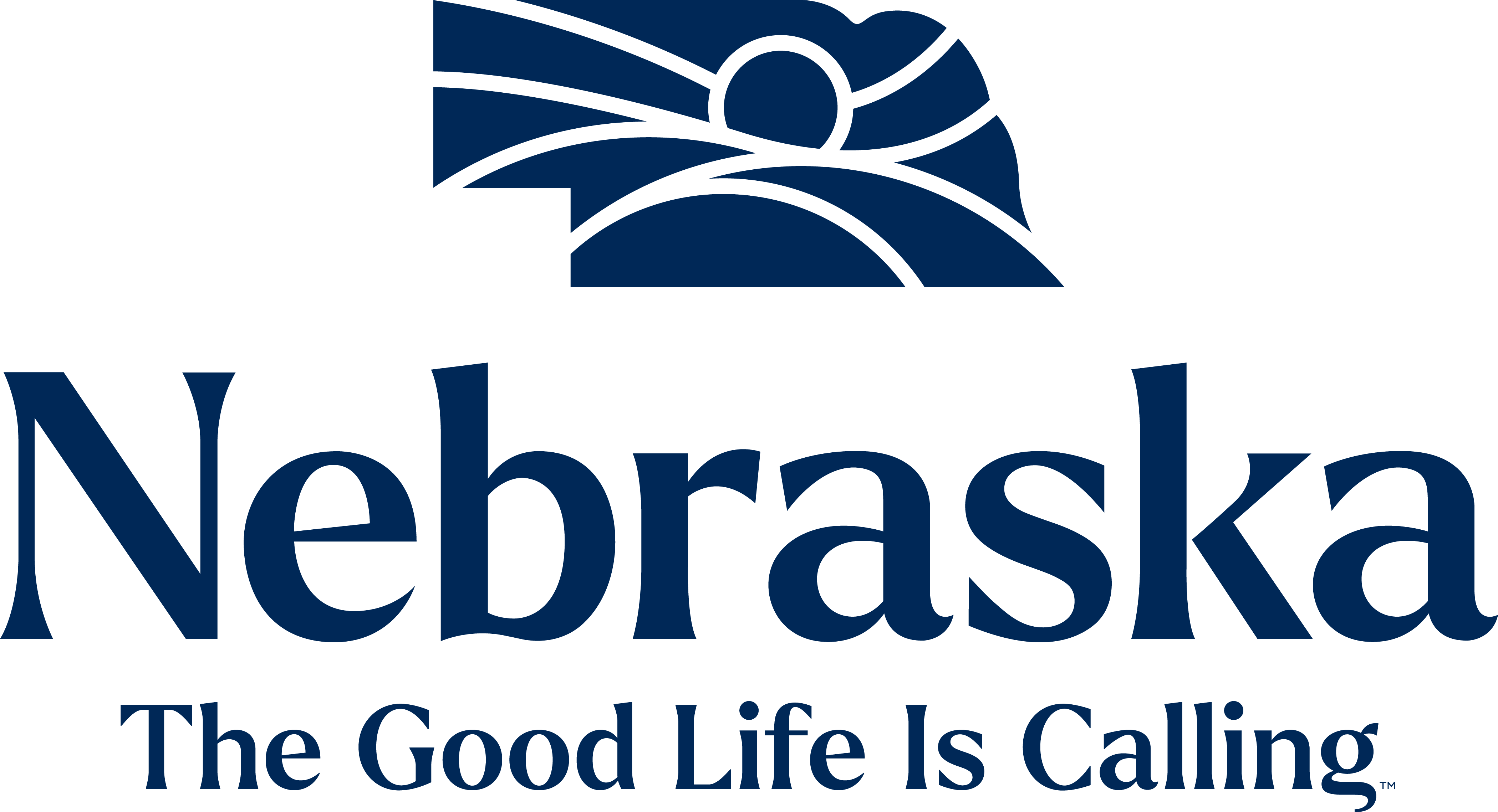Infrastructure Match Program

Purpose
The CDBG-DR Infrastructure Match Program (Match Program) is designed to provide funding to supplement the non-Federal cost share of Federal Emergency Management Agency Public Assistance (PA) and (FEMA) Hazard Mitigation Grant Program (HMGP). The Match Program focuses on developing and implementing projects that will strengthen and build resilient communities driven by the needs, opportunities, and strategies to mitigate future impacts throughout the State.
The Match Program is designed to assist public entities, local non-profit organizations, and other eligible entities by leveraging CDBG-DR funds with FEMA resources to support recovery efforts. The use of CDBG-DR funds to cover the required non-Federal cost share — or local match — will ease the fiscal strain on communities struggling to recover from the catastrophic 2019 floods.
Process Overview

Cross-Cutting Requirements
This section includes icons that capture CDBG-DR cross-cutting program requirements.
-
Blue icons indicate requirements that Subrecipients must meet under this program. Click on each icon’s hyperlink for more information.
- Gray icons indicate requirements that do not apply to this program but may apply to other programs.
Infrastructure Match Program Roadmap
This section is organized into six (6) stages:
- Identify FEMA Obligated PA and HMGP Projects: The Nebraska Emergency Management Agency (NEMA) provides a list of active FEMA PA and HMGP projects to the Nebraska Department of Economic Development (DED) for consideration. DED conducts a preliminary review to identify Low-to Moderate-Income (LMI) projects. DED announces a Notice of Intent (NOI) and notifies possible applicants under the PA and HMGP program.
- Project Analysis: DED reviews the Applicant’s NOI Pre-Application and determines which projects meet the United States (US) Department of Housing and Urban Development (HUD) requirements. DED tiers Pre-Applications and notifies Applicant if they are going into detailed project review.
- Detailed Project Vetting: DED conducts a detailed project review of the approved project elements and supporting documentation and determines project eligibility. DED requests the full Environmental Review Record (ERR) from FEMA. After the detailed review is completed, DED informs FEMA PA and HMGP Applicants whether their projects were approved.
- DED Subrecipient Selection and Setup: This stage encompasses the initial administrative steps and subsequent actions taken by Subrecipients to implement the Match Program following DED’s confirmation of project approval.
- Subrecipient Payment: Subrecipients submit invoices for reimbursement from DED and will have access to the local match funds once DED and HUD confirm compliance.
- Reconciliation and Closeout: DED will determine if a project is eligible for closeout for the CDBG-DR funded portion of the project. DED closes out the CDBG-DR grant. Subrecipients retain records for three (3) years after HUD and DED grant closeout.

Stage 1: Identify FEMA Obligated PA and HMGP Projects
Projects List
NEMA provides a list of active PA and HMGP Projects to DED. DED and NEMA use Grants Portal and EMMIE to view the most up-to-date project information.
Preliminary Review
DED conducts a Preliminary Review. Criteria for identifying match projects, in addition to Low-to-Moderate Income (LMI) and Most Impacted and Distressed (MID), is project size. When FEMA obligates a Project Worksheet (PW), it provides funds to an Applicant to initiate work. To facilitate how FEMA processes and reimburses Applicants for work, FEMA categorizes the work into two categories, “Small” and “Large” projects, based on the total dollars provided to the project. The split between the Small and Large categories is determined by using the annual Consumer Price Index, resulting in project threshold size varying by year. DED, through its project review process, collects documentation equally for Small and Large projects to determine eligibility; however, it may decide to use the project size categorization to prioritize reviews for an Applicant.
Notice of Intent (NOI)
After the preliminary review, the State will issue a Notice of Intent (NOI) and Pre-Application to invite Applicants to submit additional information to confirm eligibility.
The purpose of the Pre-Application is to document:
- How the project meets HUD’s National Objectives of Low to Moderate Income (LMI) and Urgent Need (UN);
- How the project is an eligible activity; and
- How the project is tied to the disaster, DR-4420.
Please note that the Pre-Application is simply the first step to confirming eligibility and does not constitute an application or an award.
NOI Pre-Application
Following the release of the NOI, CDBG-DR Applicants have 60 days from the date the submission opened to complete and submit the NOI Pre-Application detailing eligible Match Program projects. Applicants may choose to accept or deny the funding opportunity. If Applicants deny the funding, they should notify the State.
Stage 2: Project Analysis
Review
DED reviews the NOI Pre-Application to determine National Objective, HUD-identified Most Impacted and Distressed (MID) (e.g., Sarpy, Dodge, and Douglas counties), and eligible Scope of Work (SOW)
.
Service Area Determination
To demonstrate the applicable National Objective for a project submitted under the Match Program, DED, with assistance from NEMA and PA or HMGP Applicants, must determine the service area for the activity. To determine the project’s service area, DED and its partners will review the information contained within the FEMA PW to assess the scope, location, and accessibility of the activity, in addition to current Census boundary data. The following should be considered when determining the service area of a project:
- Nature of the activity: The size and equipment required for an activity must be taken into consideration. As an example, a small park with a limited number of slides and benches should not be expected to serve a large neighborhood. In the same way, a larger park that can accommodate a considerable number of people should not be expected to serve only immediately adjacent properties. The same applies to improvements or assistance to an alleyway versus a two-lane street versus a four-lane street in the same neighborhood. The service area for each of these infrastructure projects is different in size and population;
- Location of the activity: In general, the immediate area surrounding a facility or improvement should be included in the service area. Additionally, when a facility is located near the boundary of a particular block group, its service area could include portions of the adjacent block groups as well. If the activity’s service area overlaps multiple block groups, the entirety of the data for all block groups may be used;
- Accessibility: Geographic barriers can separate and preclude persons residing in a nearby area from taking advantage of a facility or improvement. Other limits to accessibility can include access fees, language barriers, time, access to transportation and parking, or duration that an activity is available, etc.;
- Availability of comparable activities: Comparable activities within the service area should be considered so that the service area does not overlap with the service area of another comparable activity; and
- Boundaries for facilities and public services: The service area for some public facilities and services is based on specified and established boundaries or districts. Examples of such services and facilities are police precincts, fire stations, and schools.
CAUTION: An activity that serves an area that is not primarily residential in nature does not qualify as a CDBG assisted activity under the National Objectives.
Pre-Application Tiering
Pre-Application tiering will be classified based on whether the project is in a HUD-identified MID and/or meets the LMI National Objective.
Applicant Notification
Based on the Pre-Application tiering, DED will notify the Applicant if they are going into a Detailed Project Review.
Stage 3: Detailed Project Vetting
Detailed Project Review
Following the preliminary review, DED will conduct a detailed eligibility review of approved project elements and supporting documentation, which includes, but is not limited to, the following:
- Federal and cross-cutting requirements; and
- Match share amount.
DED will request any missing documentation in writing, with the request that Applicants provide the requested documents or an appropriate plan to retrieve the requested documentation within 14 calendar days of receiving the request. Applicants who do not respond within the 14-day response period may be subject to dismissal from the program, at DED’s discretion.
Eligibility Determination
Based on DED’s detailed project review and project eligibility, Applicants will be notified of their notice of award or notice of non-selection.
Stage 4: DED Subrecipient Selection and Setup
Subrecipient Selection
During this stage, DED will conduct a capacity assessment to evaluate overall systems and management capacity to implement program activities, as well as a risk assessment to evaluate potential exposure to fraud, waste, and abuse.
DED will identify Applicants as CDBG-DR Subrecipients that have the capacity to receive the CDBG-DR funding and reimburse eligible work. Prior to the detailed eligibility review, DED will review the NOI pre-application to determine if the project is eligible based on the criteria outlined above.
Capacity and Risk Assessment
HUD requires a capacity assessment to determine whether an entity has the necessary capacity, established systems, and protocols in place to prevent waste, fraud, and abuse. A capacity assessment is a prerequisite for an entity to receive and administer HUD funds as a Subrecipient. Entities must complete and submit the form for review and evaluation before funds can be allocated to a PW. If the Subrecipient does not have adequate capacity, DED may decline their project funding or include additional clauses and special conditions in the Subrecipient Agreement that ensure the Subrecipient can manage the project’s logistics.
Where the capacity assessment focuses on whether the Subrecipient is capable of conducting the project in its current scope, whereas the risk assessment determines, based on prior experience, how likely the Subrecipient is to complete the project without waste, fraud, and abuse.
Subrecipient Agreement
Before funds are allocated to a Subrecipient, the Subrecipient must establish the Grantee-Subrecipient relationship through a Subrecipient Agreement (SRA). The SRA:
- Establishes the relationship between DED and the Subrecipient;
- Defines roles and responsibilities;
- Lays out the requirements of the grant; and
- Allows for CDBG-DR grant funds to follow the Grantee through the Match Program.
For projects receiving CDBG-DR funding, individual amendments may be utilized to update the original SRA. As appropriate, each amendment will include the scope, budget, time and performance metrics of the applicable phase. Once obligated projects are closed out under FEMA, an SRA may be amended to reflect the updated match amount and final SOW. All amendments to the SRA will be incorporated by written amendment and will not be effective until signed by both DED and the Subrecipient.
Non-Selects and Reference to Complaints/Grievance Process
Not all applications may be selected for an award. All non-select Applicants will be issued a notice of non-selection that describes reasoning for DED’s determination.
Applicants who wish to submit a complaint related to the Infrastructure Match Program or any other matters related to CDBG-DR funded programs, may do so using contact information provided on DED’s website available at https://opportunity.nebraska.gov/cdbg-dr-citizen-complaint-form/ .
Application for Funding
The Application contains and further evaluates all the CDBG-DR eligibility components of the Match Program. The application for funding cannot be approved until the SRA is executed.
Post-Award Requirements
Once funding is awarded and the SRA is executed, DED will monitor the project for compliance with requirements set forth in the SRA and all applicable Federal and State regulations. The expected period of performance following award is two (2) years.
DED also ensures compliance in accordance with the reporting requirements of the CDBG-DR Program. This includes collecting all information and reports as required under the SRA and demographic data, other information, and project documentation from the Subrecipients.
Stage 5: Subrecipient Payment
Request for Release of Funds
All HUD assisted projects are required to undergo an Environmental Review to evaluate environmental impacts of the Federal investment prior to being able to request the release of funds (RROF). Subrecipients and Applicants will submit RROFs to DED, and DED will submit RROFs to HUD through HEROS. At the completion of the Environmental Review, Subrecipients may complete a RROF to request the authority to use grant funds.
Invoicing
All Subrecipient payments are expended on a reimbursement-based payment process. “Reimbursement-based” means that project costs must be incurred by the Subrecipient and documented as required by the terms of the Subrecipient Agreement for payment of invoices.
For PA and HMGP projects receiving funds under the Infrastructure Match Program, DED makes payments directly to the Subrecipients while documenting the match payment to FEMA and NEMA.
Stage 6: Reconciliation and Closeout
Reconciliation
DED will determine if a project is eligible for closeout for the CDBG-DR funded portion of the project. A project cannot closeout under CDBG-DR until the Subrecipient has expended all funds, completed all activities, and met the National Objective. If an SRA covers multiple projects, the Subrecipient must finish each project before initiating closeout.
Closeout
CDBG-DR project closeout begins when all of the following conditions are met:
- DED has paid all projects expenses related to the CDBG-DR match payment except closeout costs, if any;
- When the Federal share for the project has been paid and FEMA will provide no more Federal share funds for the project;
- When the Subrecipient certifies that all project work is complete, and no future work will take place;
- All responsibilities detailed in the SRA and other binding agreements with DED or FEMA are fulfilled; and
- All monitoring and audit findings have been cleared, whether with HUD or FEMA.
Subrecipients are required to retain all project documents for a minimum of three years after HUD and DED grant closeout.
Frequently Asked Questions
The State of Nebraska DR-4420 CDBG-DR Infrastructure Match Program Frequently Asked Questions (FAQs) contains answers to FAQs.
Contact Information
Questions and comments regarding CDBG-DR programs should be directed to the State of Nebraska’s Department of Economic Development (DED) via email at ded.cdbgdr@nebraska.gov or by calling (800)-426-6505.

